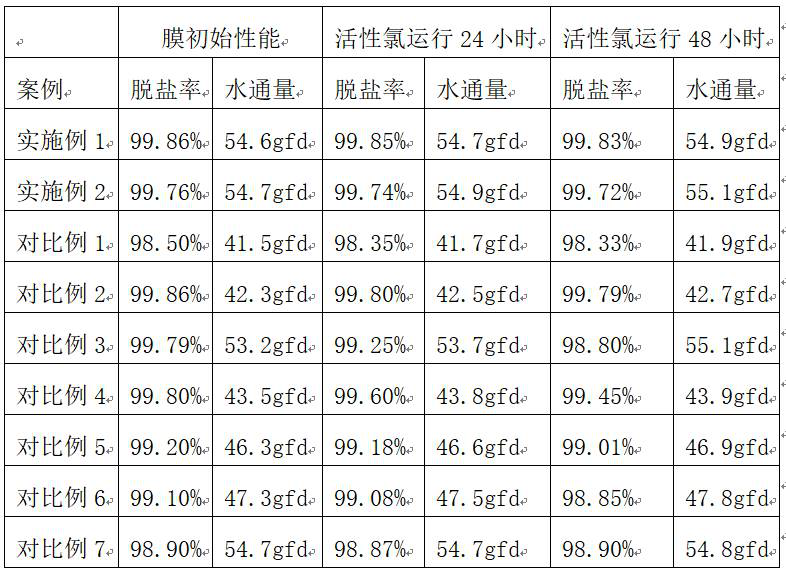Preparation method of multilayer polyamide composite reverse osmosis membrane
A technology of reverse osmosis membrane and polyamide membrane, which is applied in the preparation process of multi-layer polyamide membrane and the field of corresponding membrane products, can solve the problem of increasing the flux and retention rate of reverse osmosis membrane and increasing the bonding force between the polyamide layer and the support layer. The contact force between the film and the active layer is not strong, and the antibacterial performance is not good.
- Summary
- Abstract
- Description
- Claims
- Application Information
AI Technical Summary
Problems solved by technology
Method used
Image
Examples
Embodiment 1
[0025] The application provides a method for preparing a composite reverse osmosis membrane, comprising the following steps:
[0026] A) Preparation of base film: Weigh polysulfone resin with a weight ratio of 18% and dissolve it in N,N-dimethylformamide, add polyvinyl alcohol with a weight ratio of 4.0%, stir at 60°C for 3h, and prepare into a uniformly dispersed solution; the solution is filtered and vacuum degassed, and evenly coated on the non-woven fabric, with a wet film thickness of about 100 μm, and then immediately immersed in pure water at 20 ° C to solidify the gel and form a film, and spray on the polysulfone film 30% sulfuric acid solution at 25°C to obtain a polysulfone-based membrane;
[0027] B) Preparation of the surface modification layer of the basement film, weigh 6.0g of tris in a beaker, add an appropriate amount of ultrapure water to dissolve, transfer to a 1L volumetric flask, and adjust the pH to 6.0 with hydrochloric acid to obtain Tris-HCl buffer. ...
Embodiment 2
[0036] A) Preparation of base film: Weigh polysulfone resin with a weight ratio of 18% and dissolve it in N,N-dimethylformamide, add polyvinylpyrrolidone with a weight ratio of 4.0%, stir at 60°C for 3h, and prepare into a uniformly dispersed solution; the solution is filtered and vacuum degassed, and evenly coated on the non-woven fabric, with a wet film thickness of about 100 μm, and then immediately immersed in pure water at 20 ° C to solidify the gel and form a film, and spray on the polysulfone film 30% sulfuric acid solution at 25°C to obtain a polysulfone-based membrane;
[0037] B) Preparation of the surface modification layer of the basement film, weigh 6.0g of tris in a beaker, add an appropriate amount of ultrapure water to dissolve, transfer to a 1L volumetric flask, and adjust the pH to 6.0 with hydrochloric acid to obtain Tris-HCl buffer. Weigh 0.2 g of dopamine, add it to the above buffer solution to form a dopamine modified solution, filter the dopamine modifi...
PUM
 Login to View More
Login to View More Abstract
Description
Claims
Application Information
 Login to View More
Login to View More - R&D
- Intellectual Property
- Life Sciences
- Materials
- Tech Scout
- Unparalleled Data Quality
- Higher Quality Content
- 60% Fewer Hallucinations
Browse by: Latest US Patents, China's latest patents, Technical Efficacy Thesaurus, Application Domain, Technology Topic, Popular Technical Reports.
© 2025 PatSnap. All rights reserved.Legal|Privacy policy|Modern Slavery Act Transparency Statement|Sitemap|About US| Contact US: help@patsnap.com

